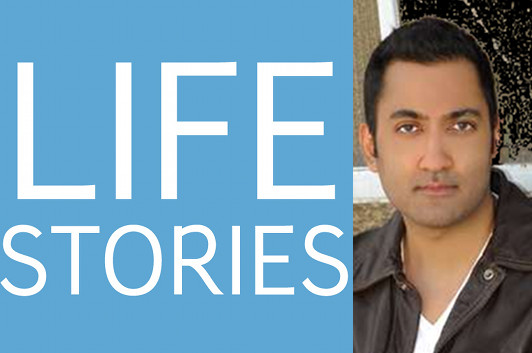Life Stories #26: Ashok Rajamani
In this episode of Life Stories, the podcast series of interviews with memoir writers about their lives and the art of writing memoir, I talk with Ashok Rajamani about The Day My Brain Exploded, his account of recovering from an AVM, or arteriovenous malformation—a cluster of veins and arteries that formed in his brain in the womb that burst one afternoon in the spring of 2000. Among other topics, we discuss just why the AVM burst when it did, Ashok’s father’s curious reaction to his hospitalization, the callousness of the doctor who performed the surgery that saved his life, and the full extent of his injuries—including what it’s like to have to rediscover your sexual orientation.
We also talk about Ashok’s decision to tell his story in order to raise awareness about the range of traumatic brain injuries—including cases like his where the extent of his condition is not immediately apparent—and how, although he’s only met one other person in “real life” who was also recovering from an AVM, he’s gotten in touch with many others, along with other brain injury victims, through the Internet. He’s also compiled a list of brain injury resources which he hosts on his website.
If you enjoyed the previous Life Stories episode with Susannah Cahalan about the autoimmune disorder that affected her brain, you’ll want to give this episode a listen—and if you haven’t heard that episode yet, then you should listen to it after you hear Ashok’s story.
Listen to Life Stories #26: Ashok Rajamani (MP3 file); or download the file by right-clicking (Mac users, option-click).
10 March 2013 | life stories |
The Writers Who Aren’t Getting Paid
The argument over people writing for online media outlets without compensation has been going on for a long time, but it recently became more pronounced thanks to a highly publicized email exchange between freelance journalist Nate Thayer and an editor at the Atlantic website. TL;DR: She asked if he’d be willing to edit down a piece he published elsewhere so she could run it as an Atlantic blog post—noting, “We unfortunately can’t pay you for it, but we do reach 13 million readers a month”—and he strongly objected to that offer; to paraphrase his subsequent comment to an interviewer, exposure doesn’t pay the bills.
Over the next few days, it’s felt like everybody’s had a response to this incident. Another digital editor at The Atlantic, Alexis Madrigal, sympathizes with Thayer—having been a struggling freelance writer himself—but argues that, right now, the best business model online media’s been able to come up with is one that puts writers at serious disadvantage. “In most cases, even great reported stories will fizzle, not spark,” Madrigal writes, speaking specifically of the traffic those stories generate and the extent to which they sell ads. “They will bring in 1,000 or 3,000 or 5,000 or 10,000 visitors. You’d need thousands of these to make a big site go.” And who can afford to pay for, and publish, thousands of those stories?
“Even a small blog, with one person at the helm, is going to need, say, 100-150 posts a month,” he continues. I think this is debatable, but it’s definitely a model that’s out there for a certain type of news/issue-oriented blog, so let’s go with it. Next, I’m going to toss some numbers out here, rather than the specific numbers he uses: Let’s say a 250-word blog post is worth $40-50, and go up to $100-150 for a longer (500-600 words) piece, of which you’ll run one a day, and we’ll assume 20 publishing days to a typical month. If you relied strictly on freelancers, this could put your monthly editorial budget anywhere between $5200 and $9500—although since you’d be likely to set aside at least one-third of the blogs to be produced in-house, let’s say $3500 to $6300 a month. Can you guarantee your advertisers $6300 worth of visibility each month? And keep in mind: I’m just talking about pieces that are no longer than a typical magazine sidebar or, at most, a one-page article—we haven’t even come close to the longform journalism of which Thayer’s article would have been an example.
Madrigal explains the shortcomings with this model well, and as the conversation gets around to “well, what if we didn’t pay some of the writers?” he offers some justifications, including exposure—later in the week, in a separate Atlantic post, Ta-Nehisi Coates admitted upfront he’d accepted exposure in lieu of cash for his earliest appearances at that blog, and he was upfront about why it worked for him: “I could not convince editors that what I was curious about was worth writing about. Every day I would watch ideas die in my head… What the internet offered was the chance to let all of those ideas compete in the arena, and live and die on the merits. And [The Atlantic] was offering a bigger arena.”
9 March 2013 | theory |


 Our Endless and Proper Work is my new book with Belt Publishing about starting (and sticking to) a productive writing practice.
Our Endless and Proper Work is my new book with Belt Publishing about starting (and sticking to) a productive writing practice. 
